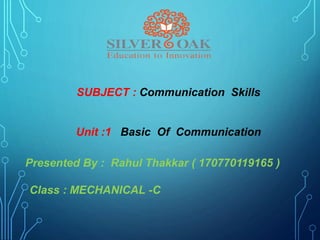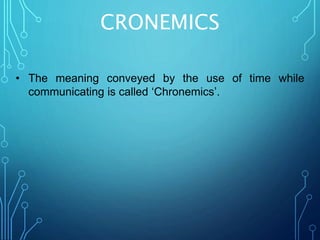Basics communication
- 1. SUBJECT : Communication Skills Unit :1 Basic Of Communication Presented By : Rahul Thakkar ( 170770119165 ) Class : MECHANICAL -C
- 3. CONTENTS
- 5. IS WHAT ?? It is aprocess of exchangingâ ï Information ï Ideas ï Thoughts ï Feelings ï Emotionsâ Through ï Speech ï Signals ï Writing ï Behavior 5
- 7. TYPES OF People communicate with each other in a number of ways that depend upon the message and its context in which it is being sent. Typesof communication based on the communication channels used are â ïķ Verbal Communication ïķ Nonverbal Communication 7
- 8. VERBA L ï§ It refers to the form of communication in which message is transmitted verbally. ï§ Communication is done by word of mouth and apiece of writing. VerbalCommunicationis divided into: ïą Oral Communication ïą Written Communication 8
- 9. ORA L ï In oral communication, Spoken words are used. ï It includes face-to-face conversations, speech, telephonic conversation, video, radio, television, voice over internet. ï Communication is influence by pitch, volume, speed and clarity of speaking. 9
- 10. ïą Advantages â It brings quick feedback. In a face-to-face conversation, by reading facial expression and body language one can guess whether he/she should trust whatâs being said or not. ïą Disadvantages â In face-to-face discussion, user is unable to deeply think about what he is delivering, so this can be counted asa fault.
- 11. WRITTE N ïIn written communication, written signs or symbols are used to communicate. ïIn written communication message can be transmitted via email, letter, report, memo etc.
- 12. ïą Advantages â Messages can be edited and revised . Written communication provide record and backup. A written message enables receiver to fully understand it and send appropriate feedback. ïą Disadvantages â Written communication doesnât bring instant feedback. It take more time in composing a written message as compared to word-of-mouth and number of people struggles for writing ability.
- 13. NONVERB AL âĒ Nonverbal communication is the sending or receiving of wordless messages. Such as gesture, body language, posture, tone of voice or facial expressions is called nonverbal communication. âĒ Nonverbal communication is all about the body language of speaker.
- 14. Nonverbal communication havethe following three elements â âĒ SpeakerâAppearance clothing, hairstyle, neatness, use of cosmetics âĒ Surrounding â Room size, lighting, decorations, furnishings âĒ Body Language facial expressions, gestures, postures âĒ Sounds Voice Tone, Volume, Speech rate
- 16. Non-Verbal Communication Can be Classified In The Following Ways : A . Kinesics B . Proxemics C . Chronemics D . Paralinguistics A . Kinesics Scientific study of âhow the body speaksâ has been labeled as âKINESICSâ.
- 17. Gestures âĒ Nodding of head, hand signals, folding arms, waving, pointing âĒ It can alert the receiver of your intentions and emotions
- 18. Posture and how you carry your self tells a lot about you. How you walk, sit, stand or hold your head not only indicates your current mood, but also your personality in general. For example, if you cross your arms while standing, you indicate that you may be closed off and defensive. Meanwhile, walking with your head down and avoiding eye contact with others may indicate shyness. 1. POSTURE
- 19. Facial expressions are the key characteristics of nonverbal communication. Your facial expression can communicate happiness, sadness, anger or fear. 2. FACIAL EXORESSION
- 20. Eye contact, a key characteristic of nonverbal communication, expresses much without using a single word. In American culture, maintaining eye contact shows respect and indicates interest. Eye contact also establish the nature of a relationship. 3. EYE CONTACT
- 21. 4. PERSONAL APPEARANCE It is the state, condition, manner, or style in which a person or object appears; outward look or aspect . OR The way you dress, fix your hair, tells a lot about yourself and the way you want others to think about you.
- 22. PROXEMICS âĒ The study of space in communication is called proxemics . Social Personal Intimate space
- 23. âĒ There are different forms of space for different times, place & situations. âĒ Intimate, Personal, Social and Public distances make up the concept of space.
- 24. âĒ Intimate Distance: actual touching to 6 to 18 inches. âĒ Personal Distance: 18 inches to 4 feet. âĒ Social Distance : 4 to 12 feet âĒ Public Distance : 12 to 25 feet
- 25. CRONEMICS âĒ The meaning conveyed by the use of time while communicating is called âChronemicsâ.
- 26. PARALINGUSTICS âĒ The study of the role of non-verbal clue is called Paralinguistics . It is about various aspects of voice . This includes , 1. Volume 2. Speed of voice 3. Intonation 4. Tone of voice 5. Pronunciation 6. Articulation 7. Pause 8. Punctuation Marks
- 27. BARRIERS OF
- 34. TOOLS OF EFFECTIVE âĒ BeBrief âĒ Manners âĒ UsingâIâ âĒ BePositive âĒ Goodlistener âĒ Spiceupyour words âĒ Clarity âĒ Pronunciation



































